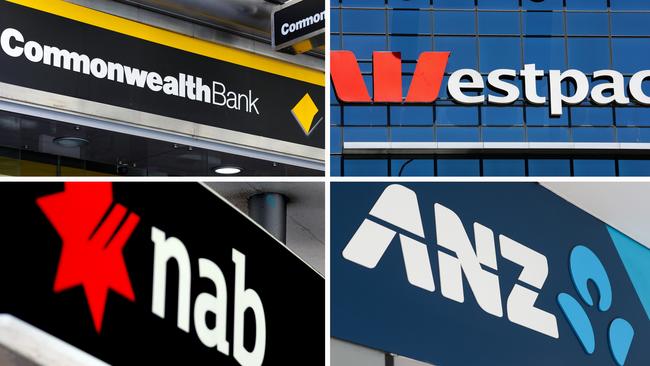After their share-price drop big banks’ franked dividends are again tempting income seekers
Bank stocks led the ASX sell-off since the start of the year but they are now offering fully franked dividend yields of 7 per cent, making investors sit up and take notice.

Business
Don't miss out on the headlines from Business. Followed categories will be added to My News.
Fully franked bank stocks are back in focus for bargain hunters after a sharp sell-off in the first quarter. As so-called defensive investments return to favour, banks are offering yields of 7 per cent.
Bank stocks led the sell-off in the ASX since the start of the year – and that may not be over.
However, stocks such as ANZ, NAB and Westpac – traditionally the backbone of independent investor portfolios – are now approaching what some analysts consider to be fair value.
The exception among the bank stocks is Commonwealth Bank which is still trading above $150 and operating in a league of its own with the highest valuation of any domestic bank. CBA is up by about 28 per cent over the past 12 months, while the rest of the “big four” have had a flat share price performance.
Importantly, bank stocks, which returned a remarkable total shareholder return of 33 per cent in 2024, are expensive on most measures and profit growth is expected to be very modest in the year ahead.
Still, for income-seeking investors, bank stocks are once again taking on the form of “bond proxies” whereby the income on offer is the primary appeal.
The recently improved dividend yield offered by three of the biggest bank stocks will not be missed by self-managed super fund investors who have held bank stocks throughout the cycle – largely ignoring the sell calls from broking houses.
The negative “calls” from top analysts are unlikely to change before the bank results season, which is set for May.
However, the key metrics for bank share prices are changing. After a long spell during which the bank share prices were very far above so-called consensus price targets, they have now dropped very close to value. The projected “downside” for ANZ is now just 4 per cent, at NAB 6 per cent and Westpac 8 per cent. (In contrast, CBA would have to fall by about 30 per cent to reach its consensus price target).
Moreover, history shows bank stocks may never descend to consensus price targets despite the best efforts of researchers to pin the perfect price for a bank stock.
One of the reasons for the enduring buoyancy of bank stocks was highlighted in recent months when bank regulators expressed concerns over the scale of bank stock ownership by major super funds.
A report from Morgan Stanley indicated that super funds own 30 per cent of shares in the major banks – and the prevalence of index investing, which is now a key feature within major super funds, means those funds must continue to buy banks to maintain their index weighting.
Among the leading bank stocks, the “grossed-up yield” – which includes franking benefits – is around 7 to 8 per cent and only CBA offers a much lower yield of 4.5 per cent.
Fund management group Airlie recently listed its bank stock concerns including margin pressure, bad debts and a mixed history in cost-cutting to conclude. “The current high bank valuations appear disconnected from long-term earnings potential,” it said.
The crunch for investors looking at total returns is whether bank stocks, with expensive valuations and low growth outlook, can continue to manage even current levels of modest profitability growth.
If they can, their capacity to keep paying fully franked dividends will continue to be highly valued too.
James Kirby hosts the twice-weekly Money Puzzle podcast
Originally published as After their share-price drop big banks’ franked dividends are again tempting income seekers





